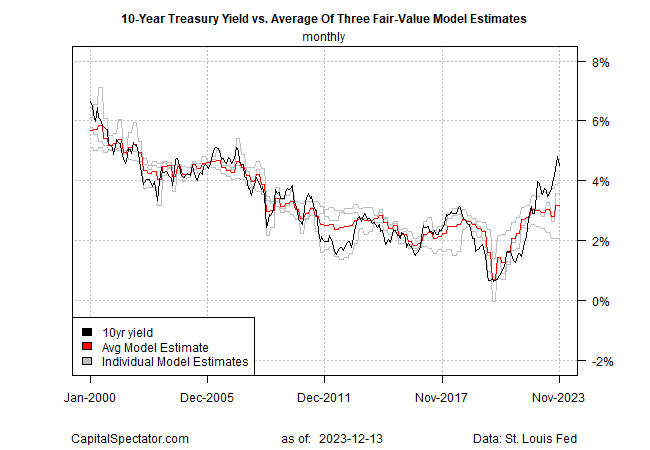10-Year US Treasury Yield ‘Fair Value’ Estimate - Wednesday, Dec. 13
Today’s update of the “fair-value” model for the US 10-year Treasury yield reaffirms that the benchmark rate appears unusually high relative to the economic fundamentals. Although that condition has prevailed for some time, the recent slide in the 10-year yield suggests market conditions are starting to normalize the gap, albeit on the margins.
As a quick recap, updates on CapitalSpectator.com in recent months have highlighted that the average fair-value estimate via three models has been substantially below the market rate. This gap persists but has started narrowing, largely due to a lower market yield.
The 10-year rate ticked down to 4.21% in yesterday’s trading (Dec. 12), well below the recent 4.98% high and close to a three-month low. The ongoing retreat from the October peak suggests that the downside momentum for the 10-year yield is ongoing.
The November fair-value estimate for the 10-year rate is 3.18% (red line in the chart below), or more than 100 basis points below the current market rate. The wide gap suggests that the market rate will fall and/or the fair-value estimate will rise, or some combination of the two. Note, however, that last month’s fair-value estimate is virtually unchanged from October and so all the latest narrowing spread has come from market changes (shown by the black line in the chart below).
The spread for the market rate less the fair-value estimate is still high – 131 basis points as of November. But the trend that’s driven the spread higher appears to be rolling over.
As noted on these pages recently, the unusually lofty spread looked unsustainable, although not unprecedented. As The Capital Spectator observed in November, “History suggests such an extreme level doesn’t last long.” A month later, the recent slide in the market rate offers a bit more support for that view.
Fair-value modeling isn’t useful for timing market changes, but it does offer useful context for marking extremes and managing expectations. On that basis, it appears that the extreme gap in the market yield vs. the average fair-value estimate has peaked.
More By This Author:
Tech, Consumer Discretionary Are Top Equity Sectors In 2023All Major Asset Classes (Except Commodities) Set For 2023 Gains
Is The U.S. Stock Market Set To Break Out Of Its Trading Range?
Disclosure: None.






